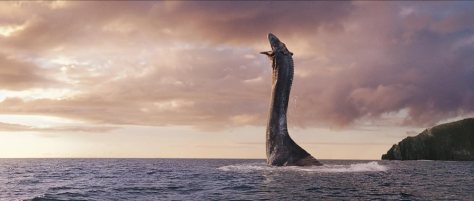
There have been films about the Loch Ness Monster pretty much from the beginning—the first movie about the monster released in 1934 (a film edited by future Lawrence of Arabia director David Lean), only a year after the first noteworthy sightings took place. Needless to say, very few of them are particularly noteworthy, so The Water Horse: Legend of the Deep can take the crown as both the most well-known Loch Ness Monster movie and the best one almost by default (I’ve already written about the only other contender.) Based on a novel by Dick King-Smith (whose book The Sheep Pig was adapted in the movie Babe), Water Horse is pitched as a traditional sort of whimsical family movie, with a cast of respected British thespians and the structure of a “child befriends an animal” story enlivened with fantastical elements ala ET. It burnishes this well-worn plot by taking advantage of the historical context of the Loch Ness Monster story, arguing why a legend like this may have resonated in an era of strife.
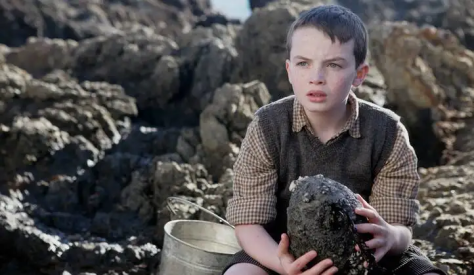
Taking place in Scotland but mostly filmed in New Zealand—home of WETA Workshop, the Lord of the Rings and Others effects studio who provided the creature CGI here—the story itself is given a frame narrative where an old man (Brian Cox) in a Loch Ness-adjacent pub ostensibly tells a pair of annoying American tourists the story of the famous 1934 Surgeon’s Photograph, which just so happens to involve a young boy named Angus MacMorrow (Alex Etel, star of the Danny Boyle film Millions) who is afraid of the dark waters of the Loch. The movie will cut back to the frame narrative, sometimes unexpectedly, as we see the old man react to his own story. Needless to say, the identity of Cox’s character, not acknowledged until the ending, should not surprise anyone who has ever watched a movie before.
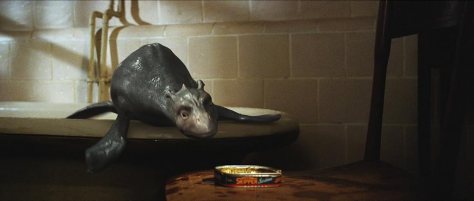
Angus and his family—his mother, played by Emily Watson, and older sister, played by Priyanka Xi—live in the massive manor house of Lord Killin, where his father worked as a handyman until the outbreak of World War II and his service in the Royal Navy. Angus obsessively maintains his father’s tool shed and has filled it with memorabilia and a timeline of his military service, but in reality his family already knows that he died a year before when his ship was sunk, and seem to only wearily indulge Angus in his denial as to not make his clear melancholy even worse. Set in 1942, the war casts a shadow over the lives of every character beyond just their own personal tragedy, becoming that vast, unknowable Thing that underlies even their attempts to maintain their regular lives. It’s the kind of gloomy atmosphere that would be beneficially punctured by, say, a mysterious egg that Angus finds in the pools around the Loch that hatches into a tiny plesiosaur-esque creature.
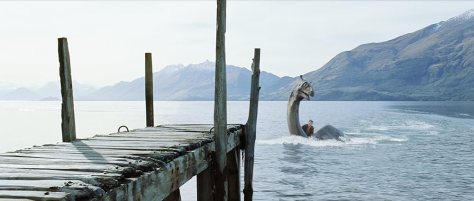
The moments after Angus finds the egg smashed open and tracks the sounds of its occupant throughout the tool shed is a blatant callback to the first meeting scene in ET, played for almost lighthearted horror before immediately shifting to the “kid establishes trust with animal” phase (including naming the creature Crusoe, because it’s also trapped on an island), and then the comedy mayhem of a small, curious organism bounding its way through places where it shouldn’t be. These are all things you expect to see in a movie like this, executed with skill thanks to the quality CGI work of WETA, who craft a cute and distinct-looking monster with enough of a balance between big eyed mammalian relatability, reptile strangeness, and a small bit of impish intelligence (I’ve always enjoyed that lake monsters are often given giraffe-like ossicones instead of horns.) There is indeed a lot of “kids try to keep their creature a secret from adults” early on, but to vary things up from the norm, Angus slowly introduces Crusoe to his sister, and then to the new handyman Lewis (Ben Chaplin), who tells them what he knows about the mythical water horses, including that only one can exist at a time. Water horses are actual mythical creatures in Scotland, and the connection between them the Loch Ness Monster have long been drawn, but to be a bit pedantic, the only detail provided by Lewis that matches the “real thing” is that some stories about them end with the water horse dragging people to the bottom of a lake.
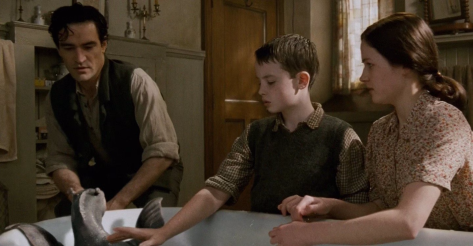
Fantasy logic and the historical setting allow the movie to move quickly, changing the situation so as not to stay too long in familiar territory. Crusoe begins growing larger and larger within days of hatching, and eventually he’s (I say “he” for convenience but they do emphasize that all water horses are “both mother and father” to their one egg) too big to live in or around the manor and is released into the Loch, where he becomes, well, Loch Ness Monster-sized. Meanwhile, almost immediately after Angus discovers Crusoe, a battalion of Royal Artillery troops led by Captain Hilton (David Morrissey) appears out of of the blue and commandeers the manor to use as a base where they can scout out German U-boats that try to spy on Britain by sneaking into the Loch. The family is not particularly impressed by this, but for the good of the nation they act as the hosts to the soldiers as they take over their surroundings and make the war something far more than a background detail. There’s an unexpectedly critical approach to the military here—Hilton and his battalion unapologetically upend the lives of the MacMorrows, and many of the soldiers are depicted in a rather negative light (especially in the third act when the existence of Crusoe becomes known.) Captain Hilton is made out to be a complex figure, at first quite disrespectful to Lewis specifically—possibly out of a sense of competition for Mrs. MacMorrow’s attention and possibly because he automatically thinks an adult man not serving in the military must be of low character, which gives his demeanour a feeling of class-based arrogance. He eventually learns that Lewis was a member of the navy and was honourably discharged after surviving an attack on his ship with an injury, knocking the Captain down a peg.
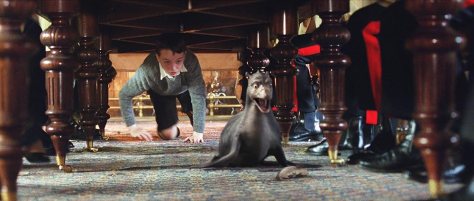
There’s a sense that the battalion are intruding on this bucolic setting—New Zealand at least looks really nice when subbing for Scotland, eye candy well-utilized by director Jay Russell (who mostly specialized in family-friendly literary adaptations like My Dog Skip)—and bringing the grinding turmoil of the war to it and its denizens. At one point, Hilton attempts to get Angus out of his grieving period by enlisting him in some minor military cleaning work, thinking that discipline is the answer, when it’s actually the infusion of something wild that does the trick. More importantly, a demonstration of their artillery cannons terrifies both Angus and Crusoe, the latter being so traumatized by the unexpected violence accidentally visited upon him that he turns borderline feral, attacking even Angus and Lewis out of fear and anger. The climax of the movie begins with the a brief Crusoe rampage when some of the soldiers attempt to hunt him down—the full-grown Crusoe does seem a bit more reptilian than he did as a hatchling, and in scenes soaked with darkness and rain he is actually legitimately frightening—and then turns full Free Willy as Angus and his family try to help the creature evade more shelling (as he is mistaken for a U-Boat) and then jump over the fence blocking him from the sea. This is a pretty obvious finale (complete with scene of the kid angrily & tearfully shouting at the animal to run away from him), but I do like how Crusoe doesn’t quite make the jump, but ends up shattering the netting with his bulk and gets away. Take that, British taxpayers!
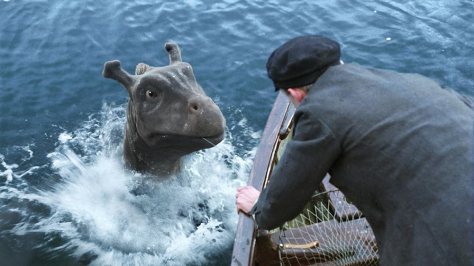
While it would certainly be pretty bold for a children’s film to be entirely critical of the British army during WWII, the movie is not anti-military throughout. The arc for Hilton demonstrates that: despite his earlier overstepping, by the climax he is helping out the MacMorrows, Lewis, and even Crusoe. In that sense, the complications this sudden onset of reality lays upon the MacMorrows is not something you can really blame on anyone, but a tragic chain of events set in motion by forces outside the control of all of them.
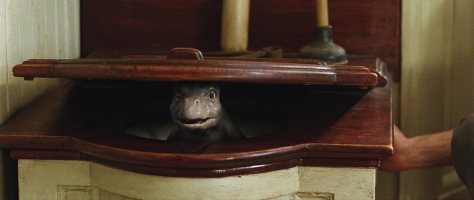
But while not completely critical, having the army’s intrusion cast something of a pall over the proceedings is one element of this story’s thesis of the Loch Ness Monster, which started showing up just as the war was breaking out. During a time of tragically fractured families, and near-universal sacrifice from ordinary citizens, this unbelievable monster brings some sense that the world has something beautiful and otherworldly left in it. In the movie, Crusoe gives Angus something to build his life around as he gradually accepts the death of his father, and when the full-grown creature takes the boy on a high-speed tour of the depths of the Loch, it cures him of the hydrophobia that was clearly a remnant of his mourning. Outside the movie, it was actually acknowledged that printing stories about lake monsters and sea serpents was a way for newspapers inside and outside of Britain to have a wondrous sort of distraction from the constant drumbeat of wartime horror stories, something you can read about in Daniel Loxton and Donald Prothero’s skeptical Cryptozoology tome Abominable Science! While it examines the cultural resonance to the monster, the movie also ties its fantastical Loch Ness story with some of the “real” ones in clever ways as well—even though Crusoe is actually cruising Loch Ness, we see that the Surgeon’s Photograph was still a hoax, created when the photographer failed to actually get a shot of the real monster in action.
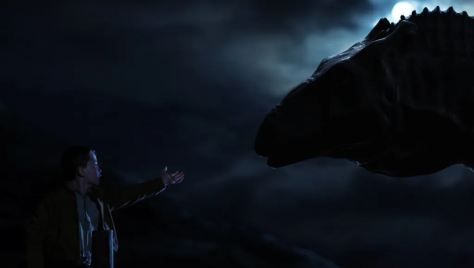
Yes, for Loch Ness experts, there’s plenty of fudged details with the timeline and related matters here. The early sightings and the printing of the Surgeon’s Photograph all took place before World War II broke out (those same pedants will also let you know that the waters of Loch Ness are too cold for anyone to be spending a lot of time in there, or about some of the geographical inconsistencies with the real Loch.) This is one of those cases where I think a little bit of condensing of history just makes it easier to express the real historical themes, not unlike what Joe Dante did with his film Matinee conflating the release of fifties atomic monster movies with the Cuban Missile Crisis in the early sixties. The point is, ultimately, that the appearance of something mythical and wonderful was an understandable and necessary thing during a harrowing period, a reminder that there are things that exist beyond even something that seems to be an all-encompassing mire. On a personal level and on a worldly level, monsters can bring some light into our lives.

